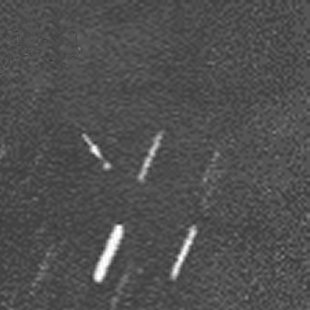

The moon first received the provisional designation S/2002 N 4 The discovery was announced on 30 September 2003 The moon was initially lost again until he was found again in August 2003 by the same team before the orbit determination. Several recordings were digitally combined until the moon is in contrast to the line-shaped stars appeared point-like. The images were taken by the 4.0 -meter Blanco telescope at Cerro Tololo Inter- American Observatory in Chile. Jacobson on recordings of 14 August 2002 discovered until 30 September 2003. Burns, Valerio Carruba, Jean -Marc Petit, Philippe Rousselot, Oliver Mousis, Brian G. Neso was on 14 August 2002 by a team consisting of Matthew J. He has the furthest distance from the central body and the longest orbit of a planet moon in the solar system. He is one of Neptune's outer retrograde irregular moons. Lissauer and Imke de Pater, 22 October 2019, Icarus.Neso ( Neptune XIII ) is the outermost of the known moons of the planet Neptune. Reference: “Orbits and resonances of the regular moons of Neptune” by Marina Brozović, Mark R. They maintain the peace by never getting too close.” “Naiad and Thalassa have probably been locked together in this configuration for a very long time, because it makes their orbits more stable. “We are always excited to find these co-dependencies between moons,” said Mark Showalter, a planetary astronomer at the SETI Institute in Mountain View, California, and a co-author of the new paper. Researchers used the observations to compute their mass and, thus, their densities - which were close to that of water ice. The work also provides the first hint about the internal composition of Neptune’s inner moons. “Only later, after its orbital tilt was established, could Naiad settle into this unusual resonance with Thalassa.”īrozovic and her colleagues discovered the unusual orbital pattern using analysis of observations by NASA’s Hubble Space Telescope. “We suspect that Naiad was kicked into its tilted orbit by an earlier interaction with one of Neptune’s other inner moons,” Brozovic said. So how did they end up together - but apart? It’s thought that the original satellite system was disrupted when Neptune captured its giant moon, Triton, and that these inner moons and rings formed from the leftover debris. There are many different types of ‘dances’ that planets, moons, and asteroids can follow, but this one has never been seen before.” - Marina Brozovic, NASA’s Jet Propulsion Laboratory “We refer to this repeating pattern as a resonance. They are two of Neptune’s seven inner moons, part of a closely packed system that is interwoven with faint rings. Naiad and Thalassa are small and shaped like Tic Tacs, spanning only about 60 miles (100 kilometers) in length. Neso, the farthest-flung of them, orbits in a wildly elliptical loop that carries it nearly 46 million miles (74 million kilometers) away from the planet and takes 27 years to complete. Some orbit in the opposite direction their planets rotate others swap orbits with each other as if to avoid collision. Some of those moons formed alongside their planets and never went anywhere others were captured later, then locked into orbits dictated by their planets. “There are many different types of ‘dances’ that planets, moons, and asteroids can follow, but this one has never been seen before.”įar from the pull of the Sun, the giant planets of the outer solar system are the dominant sources of gravity, and collectively, they boast dozens upon dozens of moons. “We refer to this repeating pattern as a resonance,” said Marina Brozovic, an expert in solar system dynamics at NASA’s Jet Propulsion Laboratory in Pasadena, California, and the lead author of the new paper, which was published November 13 in the journal Icarus. This up, up, down, down pattern repeats every time Naiad gains four laps on Thalassa.Īlthough the dance may appear odd, it keeps the orbits stable, researchers said. An observer sitting on Thalassa would see Naiad in an orbit that varies wildly in a zigzag pattern, passing by twice from above and then twice from below. In this perpetual choreography, Naiad swirls around the ice giant every seven hours, while Thalassa, on the outside track, takes seven and a half hours.


 0 kommentar(er)
0 kommentar(er)
